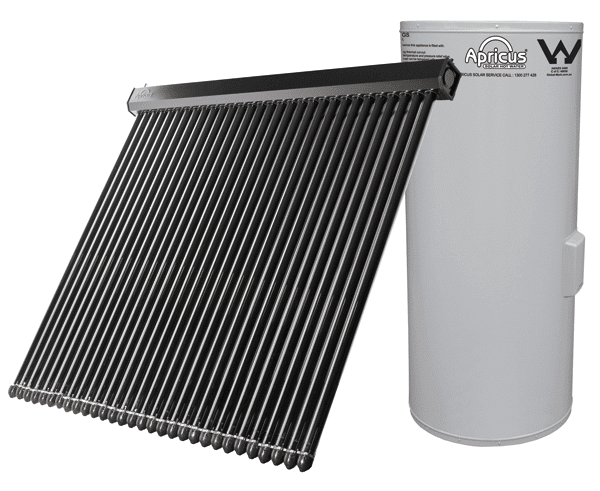
ARE YOU LOOKING FOR A SOLAR HOT WATER SYSTEM?
Specialising in solar hot water, an Apricus solar hot water system is an excellent choice for those seeking an eco-friendly alternative. They are Australia’s leading manufacturer of evacuated tube solar water heaters, and these systems utilise the latest technology.
Apricus solar hot water systems come with industry-leading warranties for complete peace of mind – something many people look for when making the switch to relatively new solar technology. Evacuated tube systems are efficient, light weight and very low maintenance, which is why they have become such a popular choice. So if you are in the market looking for an efficient Apricus Solar Hot Water System than contact Anytime Hot Water Specialist.
We offer 24/7 emergency service for Repair, Service, Replacement & installation of Apricus Solar Hot Water System in Sydney, Central Coast, Newcastle, Penrith, Windsor, Campbelltown, Wollongong & Canberra. We are one of the Award winning and authorised dealers of Apricus Solar Hot Water System. For free quote contact us on 1800 633 920 or book online and save $25. Our friendly staff is ready to take your call.
If you are considering having an apricus solar hot water system installed, Anytime Hot Water can help. For more information, contact us today.
Australia’s most trusted Apricus hot water system service provider: Anytime Hot Water.
The following are just some of the Apricus hot water systems we have available. If you are looking for a specific system not listed below, call us today and speak with an expert.
VIDEO TRANSCRIPTION
Good day, I’m Nick Humphries, founder and CEO of Apricus. This video provides an overview of the Apricus Evacuated Tube Solar Collector and the operation of a typical solar hot water system.
You can skip directly to a chapter of the video by clicking on the links below or return to this menu at any time by clicking the link in the top right-hand corner. Let’s get an understanding of the main components in a solar hot water system.
The solar collector absorbs sunlight converting it into thermal energy which is used to heat up water. The pump station circulates liquid via an insulated pipeline up to the collector and back to the hot water storage tank.
In warm regions the tank and pump station can be located outside, in cold regions they are normally located inside the building. For locations that experience freezing conditions a closed loop system with an anti-freeze liquid is commonly used.
A heat exchanger separates the solar liquid from the potable water in the storage tank either in the form of a coil pipe inside the tank or an external heat exchanger. Let’s have a look at the components that makeup an Apricus Evacuated Tube Solar Collector.
The mounting frame attaches to the roof using water-tight brackets, the inch leaded manifold box which houses the heat exchanger header pipe is fixed to the top of the mounting frame, the evacuated tubes that converts sunlight into heat are secured to the bottom of the mounted frame.
Inside the manifold box glass wool insulates the header pipe to minimize heat loss. The header pipe is a metal water heat exchanger that transfers heat from the heat pipes to the solar system liquid and is compatible with direct flow, closed loop and drain back system configurations. Next let’s have a closer look at the design of the evacuated tube.
Two glass tubes are fused at both ends with the space between evacuated at high temperatures to form an insulating vacuum. This vacuum space greatly reduces heat loss hence the high efficiency of evacuated tube collectors, an excellent performance even during cold conditions. The inner tube is coated with a material that can absorb 95% of sunlight converting it into heat.
The outer tube is transparent allowing sunlight to pass through, it is strong enough to handle hail stones greater than one inch or 25 millimetre in diameter. An important advantage of the Apricus evacuated tubes is the round absorber which passively tracks the sun throughout the day.
The round absorber provides up to 20% more output for a given surface area than a flat absorber that only faces the sun at midday. Inside each evacuated tube is a heat transfer fin, this serves the purpose of both holding the heat plug in place and also enhancing heat transfer from the inner glass wall to the heat pipe.
The heat pipe works to rapidly transfer the heat produced by the evacuated tube up to the header pipe. At the top of the evacuated tube is a support plate, a spring and washer which hold the heat pipe tightly in place ensuring optimal heat transfer. Now we can explore the design of the heat pipe.
Apricus heat pipes are made from a high purity oxygen-free grade of copper. A small volume of purified water in the heat pipe acts as a heat conducting working fluid. So how does a heat pipe work?
Under the vacuum environment inside the heat pipe water boils to form steam at only around 30 degrees Celsius or 86 degrees Fahrenheit. Water absorbs huge amounts of energy when forming steam which is the key to the high heat transfer capacity of the heat pipe.
As the steam forms it shoots rapidly to the top bulb of the heat pipe where it offloads heat to the solar system liquid that is circulating through the header pipe. As the steam offloads the heat it cools and condenses, flowing back down the heat pipe to repeat the heat conduction cycle.
Apricus solar thermal collectors convert sunlight into heat energy, not to be confused with photovoltaic panels which convert sunlight into electricity. Sunlight, including visible, ultraviolet and infrared, is absorbed by the evacuated tubes accumulating thermal energy within.
Heat pipes located in each evacuated tube rapidly conduct the thermal energy up to the header pipe located in the insulated manifold box. As liquid is circulated through the header pipe it heats up returning hotter back to the storage tank.
A controller monitors the temperatures of the solar collector and the storage tank turning on the circulation pump once the collector is hotter than the water in the bottom of the storage tank. Solar energy input gradually heats up the water in the tank.
Once the controller senses that the maximum tank temperature has been reached, normally 75 degrees Celsius or a hundred and 70 degrees Fahrenheit, the pump is switched off to prevent further heating of the water in the tank. With the pump switched off, the system allows the collector to safely stagnate, or sit hot, without causing any damage or unsafe operating conditions.
Solar radiation levels are highest in the Summer. The amount of solar radiation received throughout the year differs considerably depending on your location. The energy required for heating water is highest in the winter when cold water temperatures are the lowest.
Cold climates generally require more energy to heat water than warmer climates. For domestic hot water supply the solar collector system should be sized to meet Summer hot water requirements.
When sized for Summer hot water usage, a solar collector can meet between 50 and 90 percent of the energy demand depending on the climate and hot water usage patterns.
If there is not enough solar energy to heat water to the desired temperature back up heating is activated. There are many backup heat sources and system configurations that can be used, let’s look at the most common ones.
An electrical heating element inside the tank can boost water to the desired temperature. The element can be controlled by a timer, thermostatic switch or off-peak power supply.
The element heating capacity will normally range from two point four to four point eight kilowatts, depending on the size of the tank, it can therefore take several hours for the element to heat up a full tank of cold water to hot. Ideally boost in the few hours before the period of greatest hot water usage, this ensures enough hot water and also allows solar to work on heating the coldest water. For a household enjoying evening showers a late afternoon boost is ideal.
It is a common requirement that the tank be heated daily to 60 degrees Celsius or a hundred and 40 degrees Fahrenheit to prevent the growth of Legionella bacteria.
Rather than heating the tank water directly, a tank less water heater can boost the solar pre-heated water up to the desired temperature.
This is more efficient than using an electrical element as the gas is not maintaining the temperature of the tank water just boosting when hot water is used. A dedicated solar storage tank can supply an existing electrical gas boosted hot water system with solar preheated hot water. If the solar-heated water is already hot enough the water heater does not need to turn on.
A heater combined with a top coil tank can be used to always maintain a volume of hot water in the top of the tank leaving the solar to heat the incoming cold water in the bottom. This format is common where the heater is also used for space heating.
For optimal solar exposure the collector should face the Equator, which is the direction of the midday sun. For locations in the Southern Hemisphere the collector should face North; for locations in the Northern Hemisphere the collector should face South.
Facing Apricus evacuated tube collectors East or West of the midday sun is okay but will reduce annual heat output by about five percent when turned East or West by 45 degrees, and 16% if facing due East or West.
Solar collectors can be installed on a roof, wall, shading a window, or even at ground level. The collector should be positioned as close as possible to the hot water storage tank in order to minimize heat loss along the piping and reduce the electricity demand of the circulation pump.
For best heat output the collector should not be heavily shaded between 9:00 a.m. and 3:00 p.m., the period when solar radiation is highest.
Apricus Evacuated Tube Collectors should be installed at an angle between 20 and 80 degrees to ensure optimal operation of the heat pipes. The sun’s position in the sky changes throughout the year, highest in mid-Summer, lowest in mid-Winter. At the mid position of the cycle, called the Equinox, the angle of the sun is equal to the latitude of the location.
For optimal annual heat output the solar collector should be installed at an angle around 10 degrees higher than the latitude of the location. To maximize exposure to the Winter sun, the collector can be installed at an angle of 15 to 20 degrees higher than the latitude angle.
This higher angle also helps to reduce Summer heat output as the solar collector is not directly facing the sun.
For more information about Apricus’ products and services please visit www.Apricus.com Thank you.
